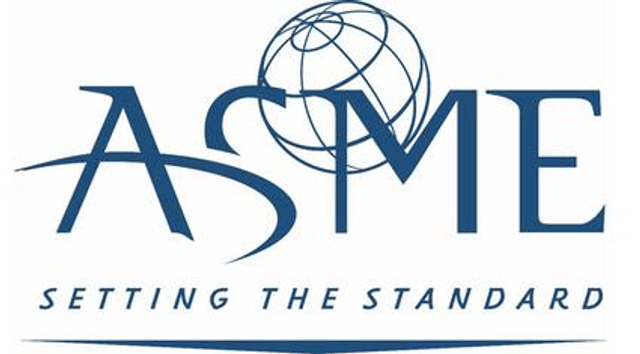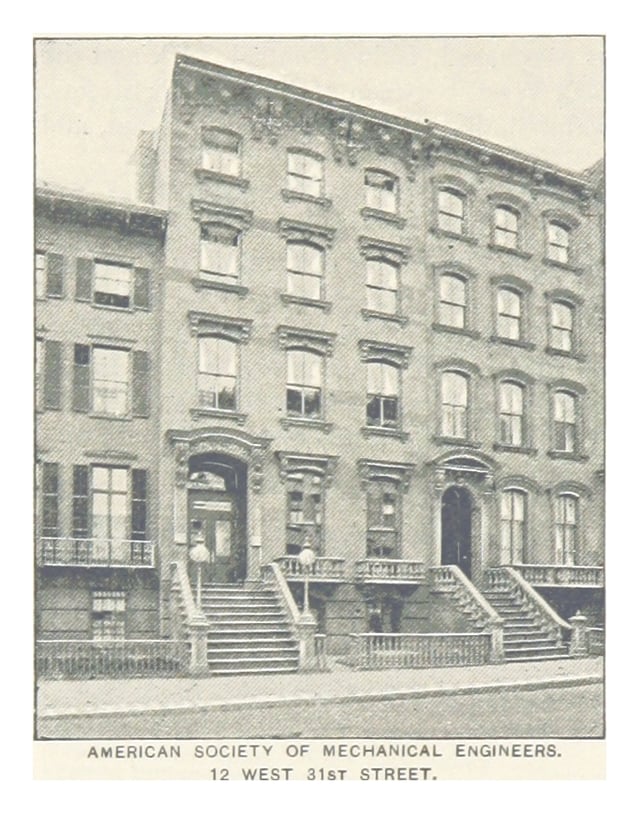ASME

ASME

| Formation | 1880 |
|---|---|
| Type | not-for-profit membership organization |
| Headquarters | New York City, U.S. |
| Location |
|
Region served | Worldwide |
Membership | 110,000+ in over 150 countries |
Official language | English |
President | Said Jahanmir |
Immediate Past President | Charla K. Wise |
Executive Director[1] | Thomas Costabile |
| Affiliations | AIChE Engineering for Change |
| Website | www.asme.org [24] |
The American Society of Mechanical Engineers (ASME) is an American professional association that, in its own words, "promotes the art, science, and practice of multidisciplinary engineering and allied sciences around the globe" via "continuing education, training and professional development, codes and standards, research, conferences and publications, government relations, and other forms of outreach."[2] ASME is thus an engineering society, a standards organization, a research and development organization, an advocacy organization[3], a provider of training and education, and a nonprofit organization. Founded as an engineering society focused on mechanical engineering in North America, ASME is today multidisciplinary and global.
ASME was founded in 1880 by Alexander Lyman Holley, Henry Rossiter Worthington, John Edison Sweet and Matthias N. Forney in response to numerous steam boiler pressure vessel failures.[6] Known for setting codes and standards for mechanical devices, ASME conducts one of the world's largest technical publishing operations,[7] holds numerous technical conferences and hundreds of professional development courses each year, and sponsors numerous outreach and educational programs.
| Formation | 1880 |
|---|---|
| Type | not-for-profit membership organization |
| Headquarters | New York City, U.S. |
| Location |
|
Region served | Worldwide |
Membership | 110,000+ in over 150 countries |
Official language | English |
President | Said Jahanmir |
Immediate Past President | Charla K. Wise |
Executive Director[1] | Thomas Costabile |
| Affiliations | AIChE Engineering for Change |
| Website | www.asme.org [24] |
ASME codes and standards
ASME is one of the oldest standards-developing organizations in America. It produces approximately 600 codes and standards covering many technical areas, such as fasteners, plumbing fixtures, elevators, pipelines, and power plant systems and components. ASME's standards are developed by committees of subject matter experts using an open, consensus-based process. Many ASME standards are cited by government agencies as tools to meet their regulatory objectives. ASME standards are therefore voluntary, unless the standards have been incorporated into a legally binding business contract or incorporated into regulations enforced by an authority having jurisdiction, such as a federal, state, or local government agency. ASME's standards are used in more than 100 countries and have been translated into numerous languages.[8]
ASME boiler and pressure vessel code (BPVC)
The largest ASME standard, both in size and in the number of volunteers involved in its preparation, is the ASME Boiler and Pressure Vessel Code (BPVC). The BPVC provides rules for the design, fabrication, installation, inspection, care, and use of boilers, pressure vessels, and nuclear components. The code also includes standards on materials, welding and brazing procedures and qualifications, nondestructive examination, and nuclear in-service inspection.
Other notable standardization areas
Other Notable Standardization Areas include but not limited to are; Elevators and Escalators (A17 Series), Overhead and Mobile Cranes and related lifting and rigging equipment (B30 Series), Piping and Pipelines (B31 Series), Bio-processing Equipment (BPE), Valves Flanges, Fittings and Gaskets (B16), Nuclear Components and Processes Performance Test Codes.
Society awards
ASME offers four categories of awards: achievement awards to recognize "eminently distinguished engineering achievement"; literature awards for original papers; service awards for voluntary service to ASME; and unit awards, jointly awarded by six societies in recognition of advancement in the field of transportation. [9]
ASME Medal
Charles T. Main Student Leadership Award
Holley Medal
Honorary Member
Kate Gleason Award
Henry Laurence Gantt Medal
Leonardo Da Vinci Award
Melville Medal
Old Guard Early Career Award
Ralph Coats Roe Medal
Soichiro Honda Medal
ASME Fellows
ASME Fellow is a Membership Grade of Distinction conferred by The ASME Committee of Past Presidents[10] to an ASME member with significant publications or innovations and distinguished scientific and engineering background. Over 3,000 members have attained the grade of Fellow.[10] The ASME Fellow membership grade is the highest elected grade in ASME.[11]
ASME E-Fests
ASME runs several annual E-Fests, or Engineering Festivals[12], taking the place of the Student Professional Development Conference (SPDC) series[13]. In addition to the Human Powered Vehicle Challenge (HPVC), the Innovative Additive Manufacturing 3D Challenge (IAM3D), the Student Design Competition, and the Old Guard Competition[14], there are also talks, interactive workshops, and entertainment.[15]. These events allows students to network with working engineers, host contests, and promote ASME's benefits to students as well as professionals. E-Fests are held in four regions in the United States and internationally[16]—western U.S, eastern U.S., Asia Pacific, and South America—with the E-Fest location for each region changing every year.[17]
Student competitions
ASME holds a variety of competitions every year for engineering students from around the world.[18]
Human Powered Vehicle Challenge (HPVC)
Student Design Competition (SDC)
Innovative Design Simulation Challenge (IDSC)
Innovative Additive Manufacturing 3D Challenge (IAM3D)
Old Guard Competitions
Innovation Showcase (IShow)
Student Design Expositions
Organization

AMERICAN SOCIETY OF MECHANICAL ENGINEERS. 12 WEST 31ST St, 19th century headquarters
ASME has four key offices in the United States[19], including its headquarters operation in New York, N.Y., and three international offices in Beijing, China; Brussels, Belgium, and New Delhi, India. ASME has two institutes and 32 technical divisions within its organizational structure. Volunteer activity is organized into four sectors: Technical Events and Content, Public Affairs and Outreach, Standards and Certification, and Student and Early Career Development.
Controversy
ASME became the first non-profit organization to be guilty of violating the Sherman Antitrust Act in 1982. The Supreme Court found the organization liable for more than $6 million in American Society of Mechanical Engineers v. Hydrolevel Corp.
See also
ASME Y14.41-2003 Digital Product Definition Data Practices
List of American Society of Mechanical Engineers academic journals
List of Historic Mechanical Engineering Landmarks
ASME Medal
ASME Boiler and Pressure Vessel Code
ASCE-ASME Journal of Risk and Uncertainty in Engineering Systems
Uniform Mechanical Code